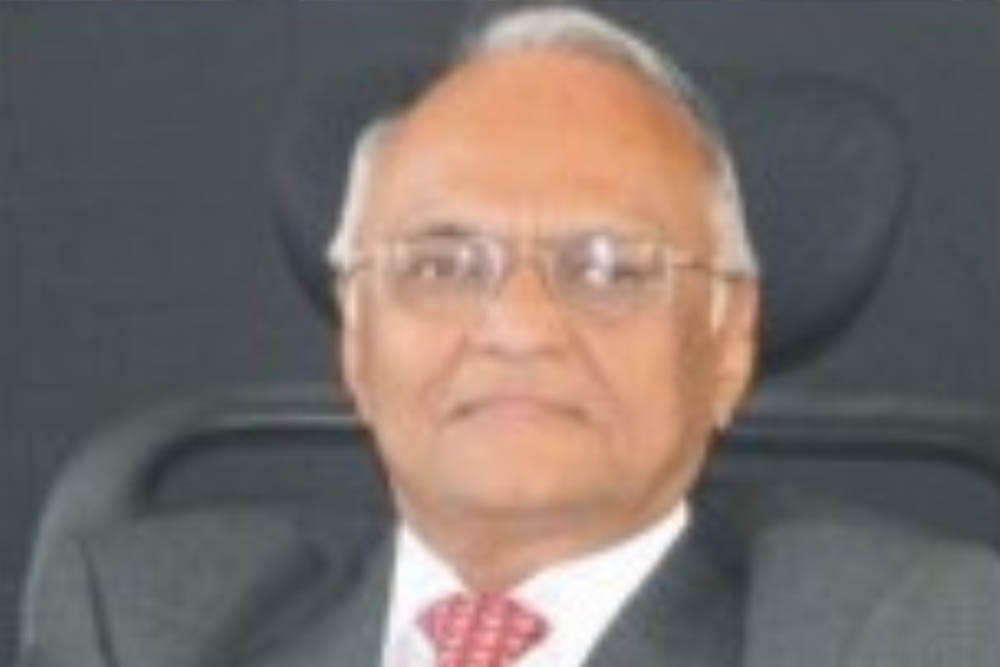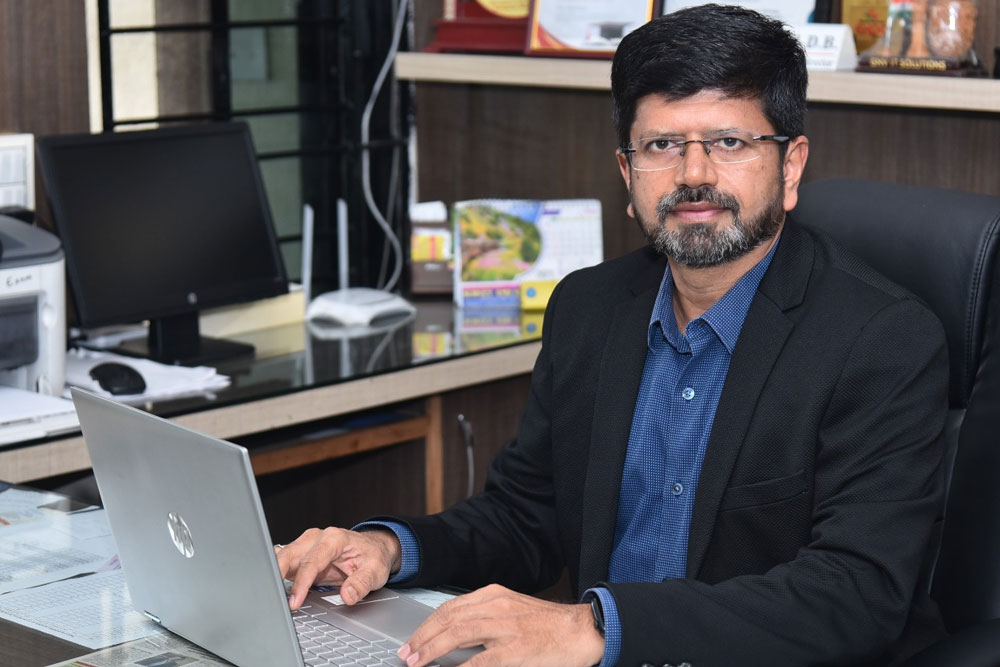 Dr. Chenraj Roychand
Dr. Chenraj Roychand A distinguished Indian educationist, entrepreneur, angel investor and philanthropist with over 40 years of experience...
 Dr. Chenraj Roychand
Dr. Chenraj Roychand  Sri. Achalchand Jain
Sri. Achalchand Jain  Dr. Ganesh D. B.
Dr. Ganesh D. B.  Master of Business Administration (MBA)
Master of Business Administration (MBA)
 Master of Business Administration (MBA) - 120
Master of Business Administration (MBA) - 120
Aryabhata was one of the earliest mathematicians and astronomers in ancient India, known for his contributions to the fields of mathematics and astronomy. Naming a lab after him would honour his legacy and contributions to science. Aryabhata's work can inspire students, researchers, and academicians in the lab to push boundaries and explore new frontiers in mathematics, science, technology and other related fields. Naming a lab "ARYABHATA" can serve as a tribute to a remarkable scholar and a source of inspiration for scientists and researchers working in the laboratories.
Labs play a crucial role in enriching students' educational experiences, promoting active learning, and preparing them for future academic and professional pursuits. They complement classroom instruction by providing opportunities for practical application, skill development, and inquiry-based learning.
In C/Python lab student will learn problem solving techniques. To teach the student to write programs in C and to solve the problems. Write programs that perform operations using derived data types. Students also acquire programming skills in core Python. Programs in C/Python cover a range of topics including basic arithmetic, functions, user input, control structures, and more, allowing students to develop their problem-solving skills in both “C” and “Python” within the framework of the lab curriculum.
A “Data structure (DS)” lab is established to develop skills for designing and analysing simple linear and non-linear data structures. It strengthens the ability of the students, to identify and apply the suitable data structure for the given real-world problem.
A “Design and Analysis of Algorithm (DAA)” lab is an essential component of a computer science curriculum, particularly for students focusing on algorithm design, optimization, and computational complexity. A Design and Analysis of Algorithm lab can provide students with a comprehensive understanding of algorithmic principles, problem-solving skills, and the ability to analyse and optimize algorithms effectively. It prepares them for academic research, software development roles, and competitive programming competitions
Dr. C. V. Raman was a renowned Indian physicist who won the Nobel Prize in Physics in 1930 for his ground breaking work on the scattering of light, known as the Raman Effect. His discovery revolutionized the field of spectroscopy and had profound implications for various scientific disciplines. Dr. Raman's life and achievements serve as a source of inspiration for scientists, researchers, and students worldwide. Naming a laboratory after him would honour his legacy and inspire future generations to pursue excellence in scientific research and innovation. By naming a laboratory after Dr. Raman, educational institutions can highlight the importance of his scientific contributions and introduce students to his remarkable achievements. It provides an opportunity to educate and inspire future scientists about the impact of his work. The lab involves hardware and software implementation of the designed circuits.
“Microcontroller and Embedded System (MES)” Lab concentrates on writing and executing assembly language programs for ARM processor. The students should write assembly program to control hardware interfaces. “Analog and Digital Electronic (ADE)” lab helps the student to understand how basic designing is done for analog and digital circuits. The lab involves hardware and software implementation of the designed circuits.
Naming a laboratory after Vijay Bhatkar would likely be in recognition of his significant contributions to the field of computer science and technology in India. Vijay Bhatkar is known for his pioneering work in the field of supercomputing and information technology in India. He played a crucial role in the development of India's first supercomputer, the PARAM series, which contributed significantly to the country's technological advancement.
PARAM is a series of Indian supercomputers designed and assembled by the Centre for Development of Advanced Computing (C-DAC) in Pune. PARAM means "supreme" in the Sanskrit language, whilst also creating an acronym for "PARAllel Machine". Bhatkar has been actively involved in promoting education and research in computer science and technology. Naming a laboratory after him would reflect his commitment to fostering excellence in research, education, and innovation.
In “Web Technology (WT)” lab, students learn to write both client side and server-side programs. Here, XHTML and CSS are used for web page creation, JavaScript for clientside validations, PHP and Servlet programs for server side to do all computations. With this knowledge, students will be able to create their own website at the end of the course. The “Computer Network (CN)” Lab- indicates a focus on the study, experimentation, and practical application of computer networking concepts. The name clearly communicates the primary focus of the lab, which is computer networking. This specialization allows students and researchers to concentrate their efforts on understanding, analysing, and experimenting with various aspects of computer networks. A "Computer Network Lab" provides a dedicated space for students to gain practical, hands-on experience with networking technologies, protocols, and equipment. This hands-on learning approach is crucial for reinforcing theoretical concepts taught in lectures and textbooks.
The name "Object-Oriented Programming Using Java Lab" indicates that the laboratory is dedicated to teaching and applying object-oriented programming (OOP) principles and practices using the Java programming language. The primary focus of the lab is on teaching and practicing object-oriented programming concepts. OOP is a fundamental programming paradigm widely used in software development, and Java is a popular language for implementing OOP principles. Java is known for its strong support for object-oriented programming features such as classes, objects, inheritance, polymorphism, and encapsulation. Naming the lab "Object-Oriented Programming Using Java" indicates that Java is the primary language used for teaching and implementing OOP concepts.
"Computer Graphics and Visualization (CGV) Lab" suggests a laboratory dedicated to the study, experimentation, and application of computer graphics and visualization techniques. The primary focus of the lab is on computer graphics, which involves the creation, manipulation, and rendering of images and graphical content using computers. This may include 2D graphics, 3D graphics, rendering techniques, and graphical user interface (GUI) development. The inclusion of "Visualization" in the name indicates a focus on data visualization, scientific visualization, information visualization, or other forms of visual representation of data and information. This may involve techniques for visualizing complex datasets, simulations, scientific phenomena, and more.
Naming a laboratory after Dr. A.P.J. Abdul Kalam would be a tribute to his immense contributions to science, education, and national development. Dr. A.P.J. Abdul Kalam was not only a brilliant scientist but also a visionary leader and a source of inspiration for millions of people, particularly in India. Naming a laboratory after him would serve as a reminder of his values, principles, and dedication to science and education. Dr. Kalam made significant contributions to aerospace engineering and missile technology during his tenure as a scientist at the Defence Research and Development Organisation (DRDO) and the Indian Space Research Organisation (ISRO). Naming a laboratory after him would honor his scientific legacy and achievements.
In DBMS lab, students learn to create tables, execute queries on aggregate functions, types of joins, nested queries, correlated nested queries, views and triggers. Analysis and Design of Algorithms lab is the platform where students can solve the problems by using various algorithm design techniques. AI & ML Lab the name "AIML Lab" conveys a clear focus on artificial intelligence and machine learning research, education, and innovation. It reflects the importance of these technologies in shaping the future of computing and their potential to impact society in profound ways. The primary focus of the lab is on artificial intelligence (AI) and machine learning (ML) technologies. These are rapidly advancing fields with applications in various domains such as healthcare, finance, autonomous vehicles, and natural language processing.
The "OPEARTING SYSTEM Lab" effectively communicates the lab's focus on operating systems and its importance in computer science education and research. It provides students with valuable hands-on experience and prepares them for careers in various areas of computing. Operating systems are a core topic in computer science education, as they provide a foundational understanding of how computers work and how software interacts with hardware. A lab dedicated to operating systems allows students to gain practical experience with concepts learned in lectures and textbooks.
The “System Software Lab” The lab may offer courses or projects focused on compiler construction, where students learn about the theory and practice of designing and implementing programming language compilers. This includes lexical analysis, parsing, semantic analysis, optimization, and code generation. The “Data Visualization with Python”- The primary focus of the lab is on data visualization, which involves the graphical representation of data to uncover patterns, trends, and insights. Data visualization is crucial for understanding complex datasets and communicating findings effectively. Python is a popular programming language for data analysis and visualization due to its ease of use, extensive libraries, and rich ecosystem of tools. Naming the lab "Data Visualization with Python" indicates that Python is the primary language used for implementing data visualization techniques and solutions.
C. N. R. Rao is a renowned Indian chemist who has made significant contributions to various fields of chemistry, including solid-state and materials chemistry. Naming a laboratory after him would honor his scientific legacy and achievements. Materials Research: C. N. R. Rao has made significant contributions to the field of materials science, particularly in the synthesis, characterization, and applications of novel materials. Naming a laboratory after him would highlight its focus on materials research and development. Interdisciplinary Collaboration: C. N. R. Rao's work spans multiple disciplines, including chemistry, physics, and materials science. A laboratory named after him could foster interdisciplinary collaboration and research efforts across different fields of science and engineering.
Angular lab- The lab may cover strategies and tools for testing and debugging Angular applications, including unit testing, end-to-end testing, and debugging techniques using browser developer tools and Angular's built-in debugging features. Students may work on real-world projects or case studies that apply Angular to solve practical problems or implement specific features. This hands-on experience allows students to apply their knowledge in real-world scenarios and prepares them for careers in web development.
